Book contents
- Frontmatter
- Dedication
- Contents
- Preface
- Acknowledgements
- 1 Introduction
- 2 The ideal MHD model
- 3 General properties of ideal MHD
- 4 MHD equilibrium: general considerations
- 5 Equilibrium: one-dimensional configurations
- 6 Equilibrium: two-dimensional configurations
- 7 Equilibrium: three-dimensional configurations
- 8 MHD stability – general considerations
- 9 Alternate MHD models
- 10 MHD stability comparison theorems
- 11 Stability: one-dimensional configurations
- 12 Stability: multi-dimensional configurations
- Appendix A Heuristic derivation of the kinetic equation
- Appendix B The Braginskii transport coefficients
- Appendix C Time derivatives in moving plasmas
- Appendix D The curvature vector
- Appendix E Overlap limit of the high β and Greene–Johnson stellarator models
- Appendix F General form for q(ψ)
- Appendix G Natural boundary conditions
- Appendix H Upper and lower bounds on δQKIN
- Index
- References
5 - Equilibrium: one-dimensional configurations
Published online by Cambridge University Press: 05 July 2014
- Frontmatter
- Dedication
- Contents
- Preface
- Acknowledgements
- 1 Introduction
- 2 The ideal MHD model
- 3 General properties of ideal MHD
- 4 MHD equilibrium: general considerations
- 5 Equilibrium: one-dimensional configurations
- 6 Equilibrium: two-dimensional configurations
- 7 Equilibrium: three-dimensional configurations
- 8 MHD stability – general considerations
- 9 Alternate MHD models
- 10 MHD stability comparison theorems
- 11 Stability: one-dimensional configurations
- 12 Stability: multi-dimensional configurations
- Appendix A Heuristic derivation of the kinetic equation
- Appendix B The Braginskii transport coefficients
- Appendix C Time derivatives in moving plasmas
- Appendix D The curvature vector
- Appendix E Overlap limit of the high β and Greene–Johnson stellarator models
- Appendix F General form for q(ψ)
- Appendix G Natural boundary conditions
- Appendix H Upper and lower bounds on δQKIN
- Index
- References
Summary
Introduction
Although the magnetic configurations of fusion interest are toroidal, one can begin to develop physical intuition by first investigating their one-dimensional cylindrically symmetric analogs: the θ-pinch, the Z-pinch, and the general screw pinch. These can be considered to be the basic building blocks of MHD equilibrium. Focusing on cylindrical systems allows the two basic problems of MHD equilibrium – radial pressure balance and toroidal force balance – to be separated, so that each can be studied individually.
The one-dimensional model focuses entirely on radial pressure balance. The question of toroidal force balance does not enter since by definition the geometry is a linear cylinder. For many configurations, once radial pressure balance is established, toroidicity can be introduced by means of an inverse aspect ratio expansion, from which one can then investigate toroidal force balance.
Chapter 5 provides a description of the basic one-dimensional configurations and how they provide radial pressure balance in a plasma. In particular, it is shown that both toroidal and poloidal fields as well as combinations thereof can easily accomplish this goal.
Included in the analysis are descriptions of two present day fusion concepts: the reversed field pinch, and the ohmic tokamak. These configurations are singled out since both their radial pressure balance and MHD stability are reasonably well described by the one-dimensional cylindrical model. Toroidal effects can be treated perturbatively and make small quantitative, but not qualitative, corrections to the cylindrical equilibrium and stability results.
- Type
- Chapter
- Information
- Ideal MHD , pp. 85 - 122Publisher: Cambridge University PressPrint publication year: 2014



